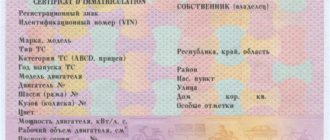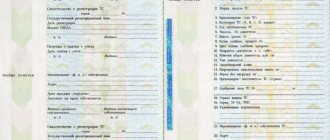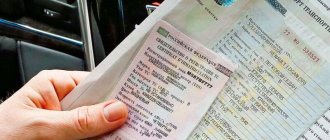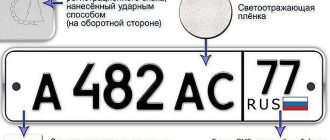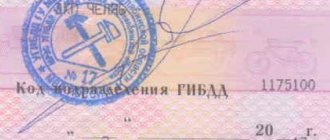Each driver, going even on a short trip, is required to have a certain set of documents with him:
- driving license;
- car insurance;
- diagnostic card;
- STS.
In the event that one of the documents listed above is missing for any reason, the driver will certainly be punished when meeting with the traffic police inspector. This may be a temporary restriction on driving a car or various penalties defined by law.
In our article we will deal with one of the most important driver’s licenses - STS.
Purpose of STS
STS is an abbreviation for the name of the certificate of registration of a vehicle with the State Traffic Safety Inspectorate; it is a mandatory document confirming registration. Considering this fact, it is clear that this certificate must be presented upon the first request of the traffic police, which means that it must always be with the driver.
This certificate has strictly established parameters by law:
- dimensions – 80 by 115 mm;
- The registration form must be filled out on both sides – front and back.
Let's take a closer look at what a vehicle registration certificate looks like.
Front side
This side contains all the information available about the car, duplicating in the main points the information located on the front side of the PTS (vehicle passport), and which displays:
- state car number;
- car release date;
- category;
- VIN code;
- car make and model;
- body, engine and chassis number;
- engine volume and power;
- body color.
The most important and, perhaps, the only difference between these certificates is that the registration number of the car is entered in the first line of the certificate.
Reverse side
This side contains all the necessary information about the owner of the car - his full name, place of residence, as well as the place of registration of the vehicle. In addition, here you can find all the basic information about the organization that issued this certificate.
An important line to check will be special marks. This field must be filled out if significant changes have been made to the design of the vehicle, for example, gas equipment has been installed.
STS number
Like any other document, the STS has its own number and series. They are expressed by three letters, three numbers and a region code. The number and series of the STS car are indicated on both sides of the document and are highlighted in bright red.
What does STS look like on a car?
What is STS in terms of vehicle data content and what does the amount of data presented in it look like? The certificate is issued on an approved form, the dimensions of which are 8 mm x 11.5 cm. The document has various degrees of protection and contains the following data:
- the license plate number of the vehicle assigned to it during registration with the State Traffic Safety Inspectorate;
- passport details of the owner (indicated in Russian and Latin);
- series and number of COP;
- name of the traffic police department that issued the document;
- a unique vehicle code indicating information about its parameters and manufacturer;
- special marks - date of purchase of the vehicle and its registration, environmental safety class;
- date of issue of the certificate;
- engine size and power;
- information about frame and chassis numbers;
- signature of the employee who issued the document.
If a person has purchased a used vehicle, then its previous owner leaves him the SOP. During registration with the MREO, the new owner will be replaced with another STS.
Where do you get the certificate?
When purchasing a car, no matter whether it is new or used, every car owner is required to register it. This procedure takes place in the vehicle registration department of the State Traffic Inspectorate of the Russian Federation. When contacting this government agency, you must provide the following list of documents:
- technical certificate;
- car purchase agreement;
- certificates confirming the cost of the car;
- vehicle owner's passport. This is one of the most important documents, without which obtaining or restoring a certificate is almost impossible;
- OSAGO – insurance policy;
- receipt of payment of the state duty, which is 500 rubles. From August 3, 2021, STS is issued in a plastic version and this option costs 1,500 rubles. Today there is an option to save a little - you can apply for registration through the State Services portal and reduce the amount required for payment by 30%, which is 350 and 245 rubles when registering for the plastic option.
If you purchased a used car with existing license plates to this list, you will also need to add the old registration document.
After the owner of the car submits all the required papers, a full check of the presented car is carried out. Provided that everything is in order with the vehicle documentation, the vehicle registration certificate will be issued within the prescribed period, which is no more than ten days.
What is the difference between PTS and STS
What is a car passport and registration certificate? What is the difference between PTS and STS is described further in our article.
A car passport and a registration certificate are the two main documents of a vehicle, which confirm such factors as the technical characteristics of the car, the year and place of manufacture of the vehicle, and the owner’s data.
Although the PTS and STS contain the same information, the purpose of the documents is different.
What documents are we talking about?
So, PTS (stands for vehicle passport) is a document that is prepared on a blue form in A4 format.
In accordance with MD Order No. 496 (regulations for filling out and issuing PTS), the following information must be indicated in the vehicle passport:
- About the car:
- make, model, year of manufacture, body type and color, vehicle category, VIN number;
- power, volume, type of engine installed in vehicles;
- numbers of installed units (engine, chassis, body, frame);
- total (maximum) mass and weight of the vehicle without additional load;
- environmental safety class;
- country and manufacturing plant;
- initial owner of the vehicle;
- data from the vehicle design approval document;
- restrictions imposed by customs;
- date of issue;
- changes made to the design of the car by the owner (indicated in a special column “Special notes”).
- About the owner:
- Full name or company name if the owner is a legal entity;
- residential address of an individual or company;
- Date of purchase;
- details of the document on the basis of which ownership rights arise. Depending on the method of obtaining the car, such a document may be a purchase and sale agreement, a certificate of inheritance, a leasing agreement, and so on;
- date of registration/removal of the vehicle with the traffic police;
- series and number of the registration certificate issued after registration (registration number).
Passports for cars can be issued:
- vehicle manufacturers, if the car was manufactured in the Russian Federation;
- customs authorities, if the car was produced in another state and is imported into the Russian Federation for use;
- Traffic police, if the document issued by the manufacturer or customs authorities is lost (became unusable, stolen, etc.).
The organization that issued the PTS is indicated in line 23 on the front side of the document.
A car passport is intended for the following purposes:
- controlling the admission of vehicles to safe operation;
- control of the import of foreign cars into the territory of the Russian Federation and timely payment of customs duties;
- reducing fraud committed in relation to motor vehicles. PTS required:
- for the purchase and sale of a car, for leasing, for concluding a gift agreement, for drawing up a will or entering into an inheritance, and so on, that is, for the alienation of movable property by any means;
- to register a car with the State Traffic Inspectorate;
- to interact with the insurance company (drawing out auto insurance contracts, receiving payments, and so on).
- STS (vehicle registration certificate) is issued exclusively at the registration department of the traffic police after the vehicle is registered and gives the right to operate the vehicle.
- A car certificate confirming the registration of a vehicle is issued in accordance with Order of the Ministry of Internal Affairs No. 1001.
- The document states:
- On the front side of the document:
- title, as well as series and number of the document;
- name (for legal entities) or full name (for individuals) of the owner;
- residential address (organization registration);
- vehicle registration plate (state plate issued after registration with the traffic police);
- VIN number;
- make, model, type and category of vehicle;
- year of manufacture of the car;
- chassis and body numbers;
- car color;
- engine power;
- environmental class;
- weight (allowed and without additional load);
- PTS details;
- code of the traffic police department that issued the document;
- date of issue.
- On the reverse side:
- date and reason for deregistration of motor vehicles;
- the name of the department of the State Traffic Inspectorate that carried out this action.
A vehicle registration certificate is required:
- for car operation;
- to issue an MTPL policy and receive insurance payments;
- to verify imposed administrative penalties.
How to obtain a duplicate PTS is explained in the article: duplicate PTS.
Read about the amount of the state duty for replacing the PTS in 2021 here.
What are the differences between PTS and STS
- The registration certificate and vehicle passport reflect similar information about the vehicle and its owner.
- In addition, each document is subject to strict reporting, that is, it has its own individual details (series, number, date of issue) and is prepared on a special form that has several degrees of protection.
- However, there are differences between these documents:
| Sign | PTS | STS |
| Purpose | – monitoring the condition of the car; – control over customs duties; – limitation of fraudulent activities | Admission to management |
| Bodies entitled to issue a document | - customs Service; – manufacturer; – State Traffic Safety Inspectorate (if replaced) | traffic police |
| Time to receive the document | Directly when purchasing a car (buying, renting, receiving an inheritance, etc.) or importing a car into the territory of the Russian Federation | After registration. The certificate is issued only if there is a PTS, which indicates the new owner of the car |
| Documents required to receive | – purchase and sale agreement (leasing, donation, etc.); – payment document confirming payment of the cost of motor transport; – civil passport | – a written application submitted to the traffic police to register a car; – PTS; – the main agreement on obtaining ownership rights; – OSAGO policy; – passport; – receipt of payment of the state duty for issuing the document and carrying out registration actions (established by Article 333.33 of the Tax Code of the Russian Federation) |
| Specified data | A complete set of information, including the re-equipment performed | Only basic characteristics of the car |
| Number of owners | It is possible to indicate the details of 6 owners | Issued exclusively to one owner |
| Replacement (restoration) | Produced for the following reasons: – loss; – theft; – unsuitability for reading the information; – lack of free fields to indicate the data of the new car owner | Done: – in case of loss or theft; – due to unsuitability; – when the owner of the vehicle changes |
| Visual differences | Blue A4 sheet | Dimensions 80*115 mm, produced on a pink sheet, laminated immediately before delivery |
| Alteration | Possible in the following situations: – changes in owner data (change of surname or address); – changes in vehicle data (refurbishment, installation of additional units, color change, etc.) | Impossible. If any parameters are changed, the certificate must be replaced |
What you need to have with you while driving
In accordance with the traffic rules (approved by Government Decree No. 1090), when driving a vehicle, the driver is required to have with him:
- driver's license with an open category corresponding to the vehicle category;
- registration certificate;
- compulsory car insurance policy.
For the absence of any document, the driver is subject to an administrative penalty in accordance with Article 12.3 of the Code of Administrative Offenses ( a fine of 500 rubles ).
That is, when driving a car, the driver must have a registration certificate, since it is this document that gives the right to operate it.
Mandatory change of document
An important point is the fact that no changes can be made to an existing vehicle registration document, and if any information about the owner of the car or the vehicle itself suddenly changes, the previously issued document will need to be changed. This procedure can be easily completed using the State Services portal, as well as at the local traffic police office.
- If the owner of the car has changed his last name or place of residence, or if the certificate is damaged, it is not necessary to present the car for re-inspection.
- If the vehicle has undergone design changes of any kind, the car will need to be brought to the traffic police department to assess the admissibility of such changes.
To obtain a new registration certificate, the car owner will need to fill out a special form, which can be printed from the State Services website or obtained from the State Traffic Safety Inspectorate. It is important to highlight the line here due to the changes that have appeared.
Restoring a certificate in case of loss
Sometimes an unforeseen situation may occur and the owner of the vehicle may lose this license or it may be stolen. The registration certificate must be presented to the traffic police inspector and contains information important for identifying the car and its owner. As experts note, the driver should always have this registration certificate, but it is better to leave the PTS at home. This is important because if you lose the STS and have a PTS in hand, the restoration of the lost document occurs quickly, but if you lose the PTS, the presence of the STS makes little difference and the restoration of the vehicle passport will be very long and troublesome. In any case, the owner of the car will have to write a statement about theft or loss - it will still be impossible to avoid a fine. An important nuance in this matter is the fact that driving a car without a license is prohibited by law and before going to the traffic police department, the owner of the car will need to take a certificate of loss of the certificate, but it will only be valid for “driving” the car to the desired traffic police department.
In such a situation, the owner will need to be patient, since driving a car without this document is strictly prohibited, and obtaining a new registration certificate will take time. How long it takes to restore depends on what exactly was missing. After the theft, it usually takes a much longer period of time to restore all the necessary documents. This is due to the fact that it will be necessary to collect a number of additional certificates, and in some cases even wait until the theft case is completely closed. The situation will be especially difficult if the PTS was lost along with the STS certificate.
When submitting all the documents required by law, the owner of the car does not have to submit receipts confirming payment of the state duty and compulsory motor liability insurance; the inspector will receive information about this independently in electronic form.
Refusal to restore a document
In special cases, the owner of a vehicle may be denied restoration of the STS. This can happen for several reasons:
- incomplete set of required documents;
- there is no tax payment stamp;
- during the inspection, deficiencies were discovered in the car that do not meet safety requirements;
- Inconsistencies were found in the documentation submitted to the State Traffic Safety Inspectorate.
If such a situation arises, the car owner must submit a written application to explain the existing problems.
Pts and sts: what are they, how are they different, how to find out the number, can it be restored?
Vehicle Passport (PVC)
A vehicle passport is documentation that contains all the main tactical and technical characteristics of a vehicle, including body color and model. In addition, this documentation contains information about everyone who was the owner of this vehicle.
The production of vehicle passport forms is carried out by the joint-stock company Goznak. The series and unique number are indicated on each vehicle passport form. We specifically emphasize that these forms are strict reporting forms.
Attention! A vehicle passport is created on:
- Passenger vehicles,
- Trucks,
- Buses,
- Trailers subject to separate registration for both cargo and passenger vehicles,
- Chassis included with a vehicle.
The following have the right to fill out a vehicle passport form:
- Employees of the Interdistrict Registration and Examination Department of the State Road Safety Inspectorate, based on the documentation provided by the owner of the vehicle,
- If a vehicle is brought from abroad, the form is filled out by employees of the Federal Customs Service,
- Employees of enterprises producing motor vehicles who are responsible for preparing vehicle passports.
Penalties in the absence of STS
As noted earlier, driving a vehicle without this certificate is strictly prohibited.
The legislation of our country provides for penalties for this violation, namely a fine of 500 rubles and delivery of the car to the impound lot until a new STS is issued (in case of loss or theft) or until the driver brings the STS (if it was left at home). Some drivers who are negligent in their duties try to drive without this certificate, hoping to convince the inspector who stopped him that the document was lost recently and they are going to restore it. Unfortunately for such “would-be drivers”, they rarely manage to convince the inspectors, and punishment will be inevitable.
Another variant of the violation would be a situation where the driver drives the car without replacing the certificate in a timely manner, for example, when changing his last name. In this case, at the first stop, the driver will have to pay 500-800 rubles, but a second stop will cost 5,000 or a deprivation of license will follow from one to three months.
